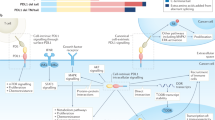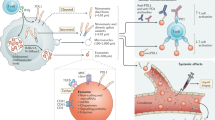Abstract
The ability of tumour cells to resist apoptosis-inducing signals by cytotoxic T cells may decide the success or failure of tumour elimination. An important effector of apoptosis is the CD95/CD95 ligand system (APO-1/Fas) that mediates perforin-independent cytotoxic T-cell killing of tumour cells. We propose a new strategy by which tumour cells can resist CD95-induced apoptosis. We identified matrix metalloproteinase-7, MMP-7 (Martilysin), as the first physiologically relevant protease that can specifically cleave CD95. MMP-7 is of unique importance because it is produced by the tumour cells themselves at early stages of tumour development. Microsequencing of the positions in CD95 cleaved by MMP-7 revealed two sites in the N-terminal extracellular domain of CD95, important for preligand assembly of CD95. MMP-7 cleavage of CD95 results in reduced CD95 surface expression and decreased CD95-mediated apoptosis sensitivity of tumour cells. Treatment of MMP-7-positive HT-29 tumour cells with MMP-7-antisense oligonucleotides led to an increase in CD95-mediated apoptosis sensitivity. Finally, specific cytotoxic T-cell killing was reduced in the presence of MMP-7. Thus, MMP-7 expression in tumour cells may contribute to an apoptosis-resistant phenotype, which ultimately promotes immune escape. This activity may account for the well-established role of MMP-7 in early tumour development.
This is a preview of subscription content, access via your institution
Access options
Subscribe to this journal
Receive 50 print issues and online access
$259.00 per year
only $5.18 per issue
Buy this article
- Purchase on Springer Link
- Instant access to full article PDF
Prices may be subject to local taxes which are calculated during checkout



Similar content being viewed by others
References
Dunn GP, Bruce AT, Ikeda H, Old LJ and Schreiber RD . (2002). Nat. Immunol., 3, 991–998.
Egeblad M and Werb Z . (2002). Nat. Rev. Cancer, 161–174.
Fingleton B, Vargo-Gogola T, Crawford HC and Matrisian LM . (2001). Neoplasia, 6, 459–468.
Galle PR, Hofmann WJ, Walczak H, Schaller H, Otto G, Stremmel W, Krammer PH and Runkel L . (1995). J. Exp. Med., 182, 1223–1230.
Galle PR and Krammer PH . (1998). Sem. Liv. Dis., 18, 141–151.
Khong HT and Restifo NP . (2002). Nat. Immunol., 3, 999–1005.
Kondo T, Suda T, Fukuyama H, Adachi M and Nagata S . (1997). Nat. Med., 3, 409–413.
Krammer PH . (2000). Nature, 407, 789–795.
Lustgarten J, Theobald M, Labadie C, Laface D, Peterson P, Disis ML, Cheever MA and Sherman LA . (1997). Hum. Immunol., 52, 109–118.
Medema JP, de Jong J, Hall, TV, Melief CJ and Offringa R . (1999). J.Exp. Med., 190, 1033–1037.
Mitsiades N, Yu W, Poulaki V, Tsokos M and Stamenkovic I . (2001). Cancer Res., 61, 577–581.
Mizutani Y, Hongo F, Sato N, Ogawa O, Yoshida O and Miki T . (2001). Cancer, 15, 287–293.
Nicoletti I, Miglioratic G, Paggliacci MC, Grignani F and Riccardi CA . (1991). J. Immunol. Methods, 139, 271–279.
Nonomura N, Nishimura K, Ono Y, Fukui T, Harada Y, Takaha N, Takahara S and Okuyama A . (2000). Urology, 55, 151–155.
Osorio LM, Aguilar-Santelises M, De Santiago A, Hachiya T, Mellstedt H and Jondal M . (2001). Eur. J. Haematol., 66, 342–346.
Pikul S, McDow Dunham KL, Almstead NG, De B, Natchus MG, Anastasio MV, McPhail SJ, Snider CE, Taiwo YO, Rydel T, Dunaway CM, Gu F and Mieling GE . (1998). J. Med. Chem., 41, 3568–3571.
Powell WC, Fingleton B, Wilson CL, Boothby M and Matrisian LM . (1999). Curr. Biol., 24, 1441–1447.
Rosenberg SA . (1999). Immunity, 10, 281–287.
Rudolph-Owen LA, Chan R, Muller WJ and Matrisian LM . (1998). Cancer Res., 58, 5500–5506.
Seki N, Brooks A, Carter C, Back T, Parsoneault E, Smyth M, Wiltrout R and Sayers T . (2002). J. Immunol., 168, 3484–3492.
Shresta S, Pham CT, Thomas DA, Grauber TA and Ley TJ . (1998). Curr. Opin. Immunol., 10, 581–587.
Siegel RM, Frederiksen JK, Zacharias DA, Chan FK, Johnson M, Lynch D, Tsien RY and Lenardo MJ . (2000). Science, 288, 2354–2357.
Strand S, Hofmann WJ, Grambihler A, Hug H, Volkmann M, Otto G, Wesch H, Mariani SM, Hack V, Stremmel W, Krammer PH and Galle PR . (1998). Nat. Med., 4, 588–593.
Strand S, Hofmann WJ, Hug H, Müller M, Otto G, Strand D, Stremmel W, Krammer PH and Galle PR . (1996). Nat. Med., 2, 1361–1367.
Tanaka M, Itai T, Adachi M and Nagata S . (1998). Nat. Med., 1, 31–36.
Theobald M, Biggs J, Dittmer D, Levine AJ and Sherman LA . (1995). Proc. Natl. Acad. Sci. USA, 92, 11993–11997.
Ugurel S, Rappl G, Tilgen W and Reinhold U . (2001). Clin. Cancer Res., 7, 1282–1286.
Vargo-Gogola T, Fingleton B, Crawford HC and Matrisian LM . (2002). Cancer Res., 62, 5559–5563.
Wilson CL, Heppner KJ, Labosky PA, Hogan BL and Matrisian LM . (1997). Proc. Natl. Acad. Sci. USA, 94, 1402–1407.
Woessner JF and Nagase H (eds) (2000). Matrix Metalloproteinases and TIMPs. Oxford University Press, Inc.: New York.
Author information
Authors and Affiliations
Corresponding author
Rights and permissions
About this article
Cite this article
Strand, S., Vollmer, P., van den Abeelen, L. et al. Cleavage of CD95 by matrix metalloproteinase-7 induces apoptosis resistance in tumour cells. Oncogene 23, 3732–3736 (2004). https://doi.org/10.1038/sj.onc.1207387
Received:
Revised:
Accepted:
Published:
Issue Date:
DOI: https://doi.org/10.1038/sj.onc.1207387
Keywords
This article is cited by
-
Serum matrix metalloproteinase-7: a potential biomarker in patients with Lynch Syndrome
Molecular Biology Reports (2023)
-
MMP7 cleavage of amino-terminal CD95 death receptor switches signaling toward non-apoptotic pathways
Cell Death & Disease (2022)
-
Tissue inhibitor of matrix metalloproteinase-3 has both anti-metastatic and anti-tumourigenic properties
Clinical & Experimental Metastasis (2020)
-
SheddomeDB: the ectodomain shedding database for membrane-bound shed markers
BMC Bioinformatics (2017)
-
Serum MMP7, MMP10 and MMP12 level as negative prognostic markers in colon cancer patients
BMC Cancer (2016)



